It’s common to overlook the importance of a headline. Whether you like it or not, a headline is what will determine how many people actually read your content. Even if your content is truly unique and innovative, a weak headline will ruin its chances of being super successful.
Fortunately, data and analytics combined with these 73 tips can help you write great headlines that will instantly capture the attention of your readers. We don’t want your content to go to waste because your headline didn’t perform well enough, so we’re here to make sure you can craft the most compelling headlines possible.
1. Understand the Importance of Writing Great Headlines

Your headline makes your first impression with readers. A strong headline can drive more clicks. A weak one can send traffic away.
That’s why it’s important to spend time getting them right.
25 headlines might sound like a lot. However, if anything, you could consider this the bare minimum. Some will be better than others. Some, in fact, will be downright terrible.
That’s okay though. You have to burn through bad ideas before you can find what works.
Your brain was made for this. Headline generation is just another form of idea generation that forces you to use your brain’s reticular activating system (RAS) to inspire creativity. RAS is an important part of our brain that is used for things like breathing, sleeping, waking, and the beating of our hearts. It is basically the part of the brain that works when we aren’t.
By forcing ourselves to generate more than a few headlines, we put our brain to work using our RAS. We may think of 10 headlines right now, and then suddenly generate a few more when we aren’t even trying (or while writing the post itself).
This is your RAS at work. It is subconsciously providing you with creative ideas while you are busy doing other things. As much as we try to systematize it, creativity is often very spontaneous, and can actually get “better” with time.
From Psychology Today:
The creative process moves through five stages. It begins with preparation–an analytical time when the basic information or skills are assembled. It continues on to incubation–a more intuitive and subconscious time in which you connect the dots in a default state. If you stick with it through perspiration, this process will eventually lead to revelation–the eureka experience when you literally feel the tumblers of your mind click into place and you say: ‘A-ha, I have found the solution!’ The creative process ends with production, a time when the insights are put into a useful form and shared with others.
Headline generation lives right there between incubation and perspiration. But, what’s even more interesting is how our ideas develop over time. This is something that Tim Hurson calls the third third.
Discover how to craft compelling Google Ads headlines that capture attention and drive clicks—start creating now!
2. Follow the Rule of the Third Third
In his book, Think Better, Tim Hurson defines an interesting phenomenon that clearly proves why more headlines are better than just a few. One of his key points is the miracle of the third third. It works something like this: if you are looking to generate 100 different ideas, studies have shown that the ideas will generally fall into three different groups.
- The first third (up to idea 33): This group will consist of the most obvious picks. They’ll be “typical” and won’t usually represent anything new or interesting. In other words, they will be the least creative. If you are like most bloggers, this is where most of your headlines come from. Oops!
- The second third (idea 34 to 67): During the second third, your ideas will start to gain some momentum. You will begin to think more creatively and start to generate some actual “new ideas.” But, don’t stop there. Many of them will still be based on prior knowledge and experience.
- In the third third (ideas 68 – 100): The final third will represent your best chance at coming up with a unique and innovative idea. During the first two thirds, you were able to exhaust the obvious ideas, forcing the new and unique to float to the top.
As you develop ideas, each new one will be more and more difficult to come by, but this is a good thing!
Once the obvious ideas have been exhausted, you make room for the not-so-obvious. This is why repetition, time, and perseverance are so important to the idea generation process.
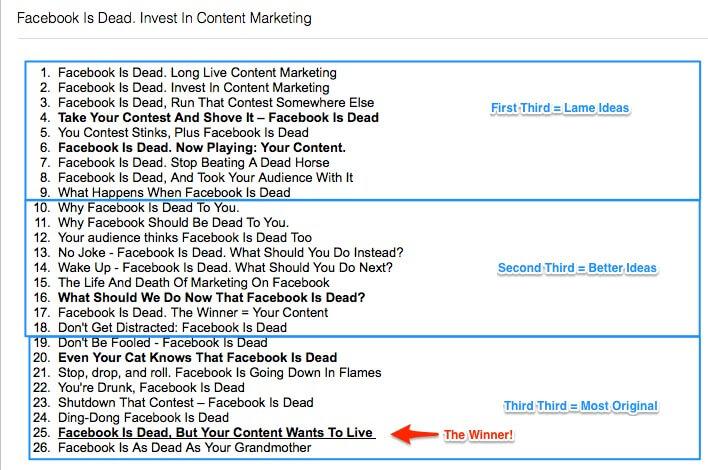
My brainstorm clearly followed the rule of the third third.
In the previous example, there is a clear example of the third third phenomenon at work. When you break down my headlines you can see that I clearly got more “desperate” and more creative toward the end. The winning headline actually came from my final third. It’s pretty telling, and makes you wonder — what would have happened if I’d written 100?
Malcom Gladwell is famous for telling us that it takes 10,000 hours to become an expert. The question here is how many headlines does it take to make a good one? If nothing else, we know that experience pays. By putting headlines into an idea generation process, we activate our RAS, push our creative comfort zone, and slowly get better at it over the long haul. You know what they say: practice does make perfect.
3. Start By Writing 10 Headlines
The first step is to start. Begin by writing out at least 10 headline ideas for your post. For this method to really work, it is important that you make these steps a habit. Even if you feel like the one you have is pretty good, force yourself to write at least ten more.
4. Next, Write 15 More Headlines
Now do it again. Write another 15 headlines.
5. Cross Out the Worst 15
Often, deciding what headline to not use will be easier than deciding which one to use. This is why it works so well to remove your least favorite right from the start.
6. Bold Your Top 5
Chances are, what’s left are a few pretty good headlines, several boring ones, and maybe one or two great headlines. Choose your top five and make them bold.
7. Conduct a Poll
If you work in a writing team, or have an editor assigned to you, now might be the time to take advantage of them. Let them take a look at your list and decide which headline they think fits best. Match it to your list? How did it shake out?
8. Do an A/B Test
A/B testing is a great way to test our assumptions and our work. Rather than simply picking the headline that we like best, choose two and test them against one another. One way that we do this regularly is through our email software. We send our email with two different headlines and then see which performs the best. Of course, you’ll have to have a headline selected at that point, but don’t let that stop you from testing your work.
Another simple way to test headlines is to use Twitter. Once the post is live, send out a variety of tweets with each headline. The one that gets the most clicks wins!
Use email to a/b test your headlines.
I know that much of this doesn’t sound overly scientific, and it’s not. The goal is to learn to become a better headlines writer. The more we know, the better we will do next time.
9. Go With It, Then Learn
At some point you just need to pick a headline and go with it. You might get it right and you might get it wrong — no matter what, you need to move on. Just don’t forget to track your results and learn from the process. The most important part of learning to write better headlines is practice.
No matter how much science has our back, writing great headlines is more of an art form than a science, and that is exactly why we need to be using this method. It may sound hard at first, but the activity can be very useful. I often find myself heading well past the 25 headline threshold. Usually they get better with time. To prove my point, here is the link of headlines that I generated for this post. How did I do?
10. Use the CoSchedule Headline Analyzer Studio
It’s not enough to guess at what a good headline looks like, though. You need a data-backed way to sort winners from losers. This is where the Headline Analyzer Studio comes in:
1. Type in a few different headline options.

2. The Headline Analyzer will list them for easy comparison purposes.

3. Scroll down to find your Score and Word Balance.

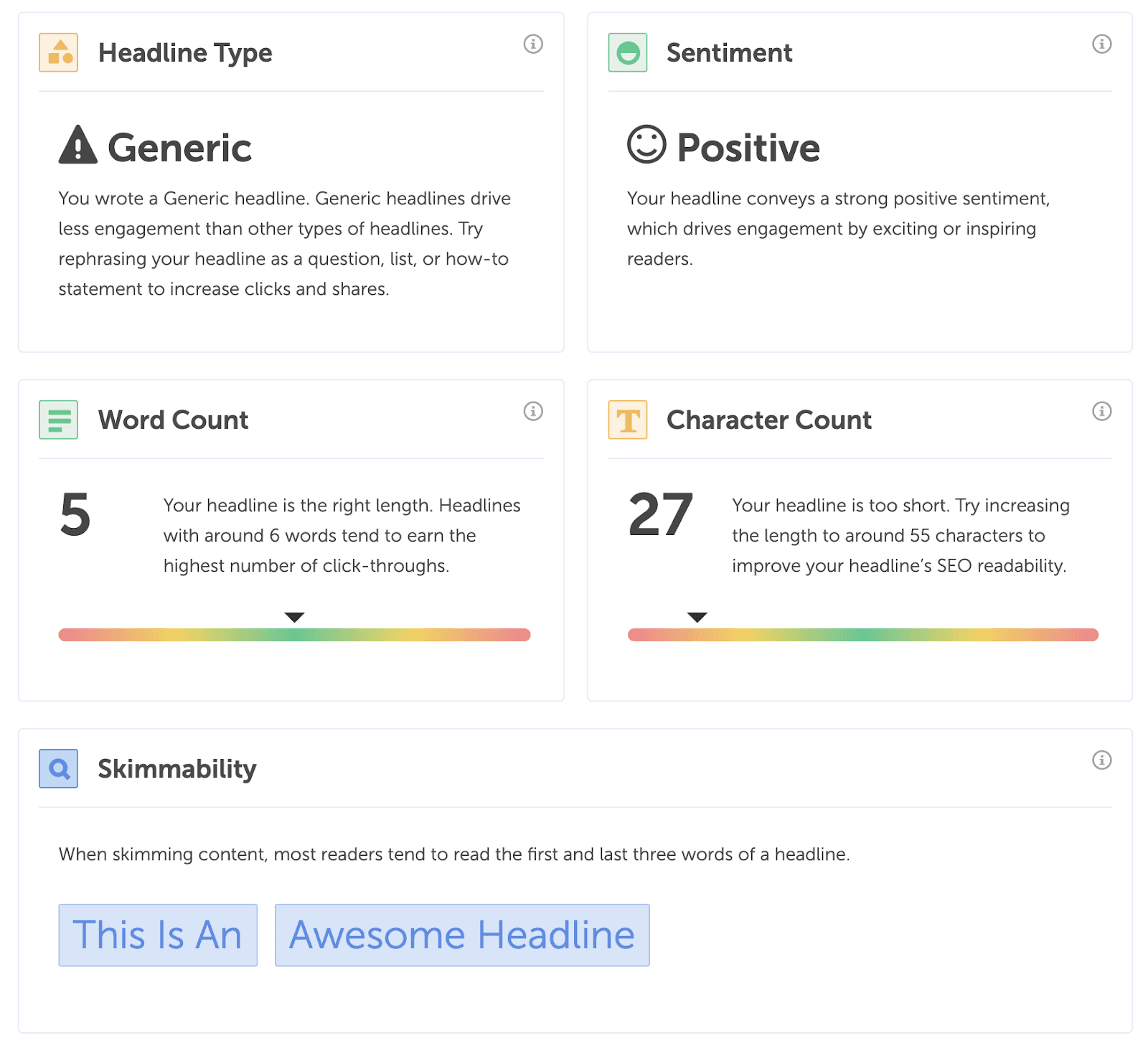
The Headline Analyzer Studio is also built right into your content calendar in CoSchedule to help you write the best headlines right where you organize everything else.
11. Focus Your Headlines on Helping Instead of Telling
Have a look at the most popular Google searches — they’re mostly about solving a problem in the easiest and fastest way.
This Mashable post entitled, “How to Pay, Exercise and Take Photos Using Apple Watch“, gained more than 1,500 shares — mainly because it addresses an issue owners of this cutting-edge device find relevant to their experience.
Pro Tip: “How to” headlines get you instant bonus points with CoSchedule’s Headline Analyzer Studio.
12. Suggest the Best Way to Do Something
Successful headlines connect with common searches and address a real target audience looking for the most effective strategies for solving their problem.
Content starting with “The best way to…” has the potential to go viral super quickly.
Pro Tip: Headlines with “best” and “better” also score higher with CoSchedule’s Headline Analyzer Studio.
13. Give Advice for Improvement
Instead of persuading your readers to do something, show them why it’s worth the time to do it. Addressing the reasons and motivations of your readers serves as the basis for a really powerful message.
Consider this extremely popular post entitled, “Why You Should Forget Facebook“. The headline promises to resolve the cognitive dissonance it creates. After all, why should anyone want to ignore the largest social network? A headline like this one practically guarantees traffic.
14. Provide Solid Evidence to Support a Claim
There’s nothing more powerful than the “Backed By Science” claim. Insights derived from research are considered more accurate, relevant, and attractive.
Have a look at this post from Inc.com on “10 Productivity Strategies Backed By Science“. It has more than 1,100 shares — primarily because readers consider scientific findings credible.
15. Share Your Experience
“What I learned” is another great headline strategy. Speaking to your readers from experience, you’ll not only gain their trust, but also promise a solution that really works.
A striking example of this kind of content is “What I Learned from Being a Broke, Unemployed Graduate” published on Entrepreneur. That article’s 19,000+ shares speak for themselves.
16. Avoid Clickbait
The era of clickbait supremacy is over. Audiences have caught on. If your headline over-promises and under-delivers (which clickbait does 100% of the time), readers will leave disappointed.
Here’s a good example of what NOT to do:

If you decide to be brave and read on, you’ll find out it’s — wait for it — a rock. Pull something like this, and you’re sure to chase away any audience you have.
17. Ensure Your Headline Aligns With Your Content
Your headline should accurately reflect the angle of your content.
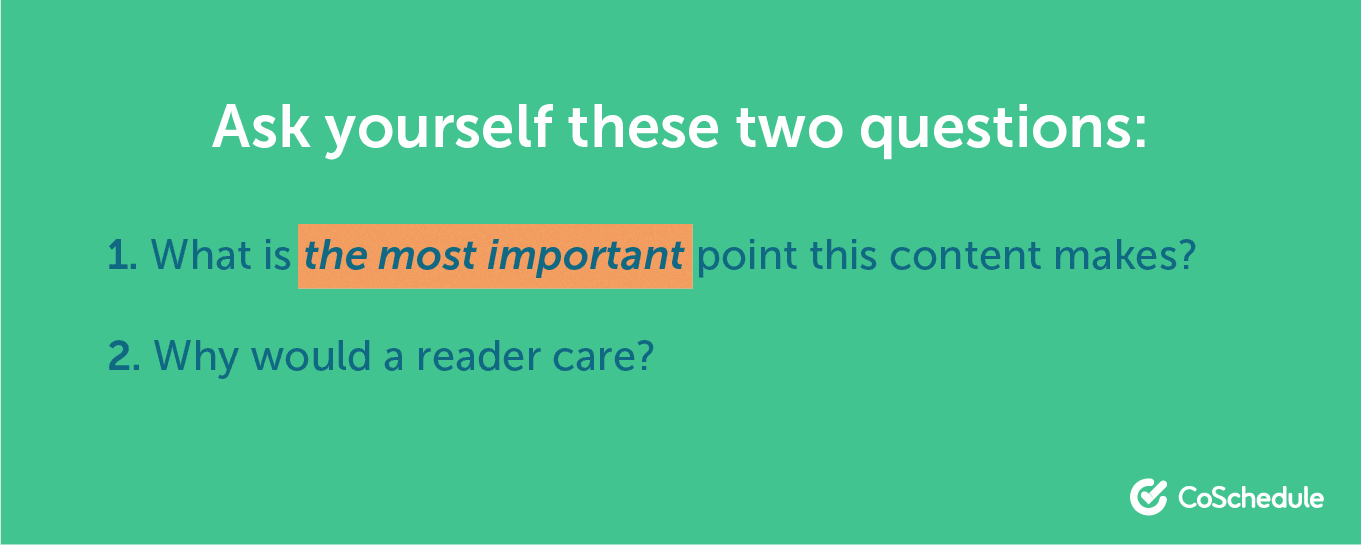
If your headline doesn’t address each of these points, it’s time to start over.
18. Include Numbers in List Headlines
Writing a list? Include how many items it includes right away. This gives readers a clear idea of what to expect.
19. Experiment With Open- and Closed-Ended Questions
Open-ended questions are great for encouraging discussion (e.g. When Are The Absolute Best Times To Send Email?). Closed-ended questions, meanwhile, are effective for inspiring curiosity (e.g. Do You Send Email At The Absolute Best Times?).
Test each to see what performs best for you.
20. Hint at Something Interesting
Leave out just enough detail to get readers interested (without falling into the clickbait trap).
For example, something like, “This New Car Door Design Is Changing The Game”, might get an audience interested in knowing exactly how that hypothetical car door design works.
21. State a Problem and Offer a Solution
It can be tough to stoke a problem and offer a solution in one headline. However, when done well, this technique can offer a solid emotional one-two punch. Here’s a great example from Fast Company:

It introduces a problem (one that readers might not even recognize as a problem). It then promises to show what the solution might be.
22. Include a Stat
People love to see numbers in headlines. This is especially true when they seem difficult to believe.
If you have a powerful statistic in your content (like in this example), put it in your headline.
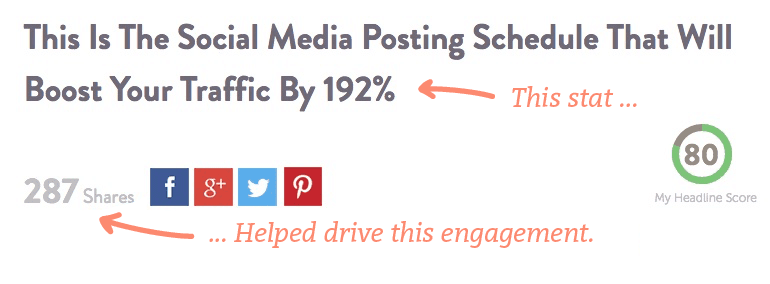
23. Know Your Audience
Make sure you know who your real audience is, and understand what their interests are. You can do this with a little bit of research in Google Analytics.
24. Speak Like Your Audience
Use words and language your audience uses. That includes the same types of jargon and technical terminology. You can get a sense of how your audience talks and what words they use simply by participating in social media conversations with them.
25. Be Relevant and Topical
The best written headline is useless if your audience doesn’t care. Craft headline copy that targets relevant topics and discussions happening in your industry or niche. Likewise, avoid straying onto topics outside of your scope.
26. Aim for Headline Analyzer Studio Scores of 70 or Higher
Anything lower needs improvement. Holding yourself to this standard will ensure you write more effective headlines.

27. Understand How Emotions Impact Headlines
This study from Moz shows that readers like content that is either understated and features up to one superlative word or goes overboard with superlatives to show why the content is worth reading.
What does it mean for you? If you want your content to go viral, your headline must be located at one of those two extremes; otherwise it won’t catch anyone’s attention.
Here are some words invoking both positive and negative sentiments:

28. Understand What Word Balance Means
The Headline Analyzer Studio breaks down words into four categories.
- Common: These are words frequently used in English. They’re recognizable and easy to read terms.
- Uncommon: These phrases are used less frequently in common English. They’re effective for creating intrigue.
- Emotional: Hit your readers right in the feels. Literally. These words drive action by targeting desired emotions.
- Power: These words inspire feelings of motivation and empowerment.
For examples of each category, download the Headline Analyzer Studio tear sheet included in this post.
29. Use Positive Superlatives for a Strong, Emotional Headline
Positive superlatives that will help you in headline writing are as follows: best, always, fastest, easiest, most, greatest, largest, funniest, hottest, strongest, biggest, ever, perfect, top.
30. Try Negative Superlatives to Draw on Fear and Doubt
What are negative superlatives? Never, worst, nothing, no one, no way, by no means, none. Featuring words like stop, avoid, or don’t in your headline is a good idea, too.
Pro Tip: Use the Headline Analyzer Studio to understand whether your headline’s sentiment is positive or negative. Neutral headlines tend to perform worse than extremely positive or negative headlines.
31. Front-Load Your Headline Structure
Make sure that your superlative — whether it’s positive or negative — is always at the front of your headline. “7 Worst Mistakes Of Young Startups” sounds much better than “7 Mistakes Made by Young Startups That Are Worst”.
32. Going Extreme Can Be Worth It
Using aggressive or violent words, like “kill”, “fear”, and “dead” actually generates more social shares. If these expressions fit your context and aren’t offensive to anyone, use them to draw even more emotion from your readers.
- Proof That Emotional Headlines Get Shared More On Social Media
- YouTube SEO: The Ultimate Guide To Boost Visibility And Rankings
- Stay Ahead Of The Curve: The Best YouTube SEO Tools For 2024
33. Be Careful With Humor
Like avoiding ambiguity, avoid puns or jokes. Your headline must be understandable outside of its context.
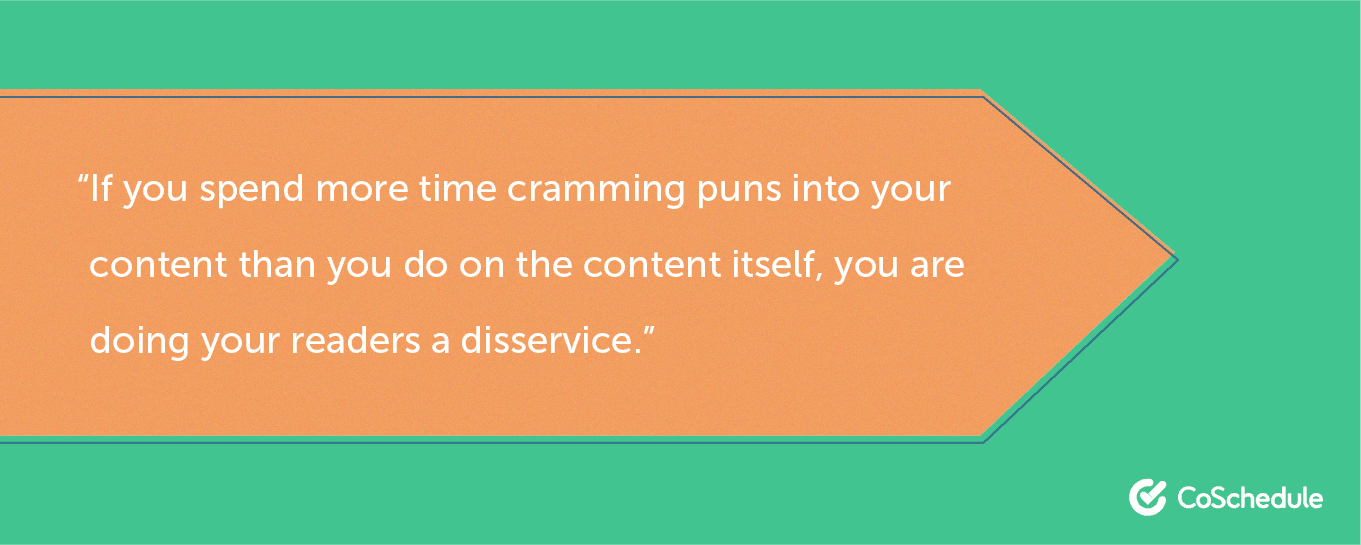
34. Invoke Urgency
Is your content time-sensitive? Use words that inspire urgency.
For example, say you’re writing about an upcoming event with a registration deadline. Something like, “Register For Our Webinar Before Time Runs Out”, lets readers know they’re on the clock.
35. Make the Unbelievable a Reality
If your content includes something strange but true, use that to your advantage. For example, an article about 55 kids playing soccer against two pro soccer stars deserves a hyped up headline.
If your content is good enough, your headline will sell the story without resorting to cheap clickbait tactics.
36. Understand Ideal Headline Lengths
A Kissmetrics study shows that readers tend to absorb only the first three words and the last three words of a headline. Keeping a headline no longer than six words will help readers easily process it and reduce the interaction cost involved in grasping its meaning.

If you can’t limit your headline to six words, bear in mind that it’s the first and last words that count most. Use this knowledge to your advantage by including attractive keywords in these places.
Here’s what to remember when writing your headline:
37. Understand the Media Types Where You’ll Use Your Headline
The length of your headline depends on what you want to do with it — different lengths work for different media like emails, social networks, search engines, and language engagement.
38. Avoid Ambiguity and Get to the Point
If you want to follow the traditional strategy, write headlines that are information and keyword-rich, match the expectations of your target audience, and are understandable even when taken out of context. This also means keeping them relatively brief (if possible).
39. Know the Best Length for Your Language
If you want your headline to perform well, consider the following for English: It should be between 60–100 characters and 16–18 words long.
Remember that every language has its own rules — only testing can unveil what really works.
40. How Do Your Headlines Appear?
Moz also surveyed their respondents about their headline capitalization preferences.
And guess what?
Apparently, 21% of them admitted that they liked to be shouted at with headlines written in capital lettering. If you want to go for a safer approach, just capitalize your words in the title case — 64% of respondents reported to like this.
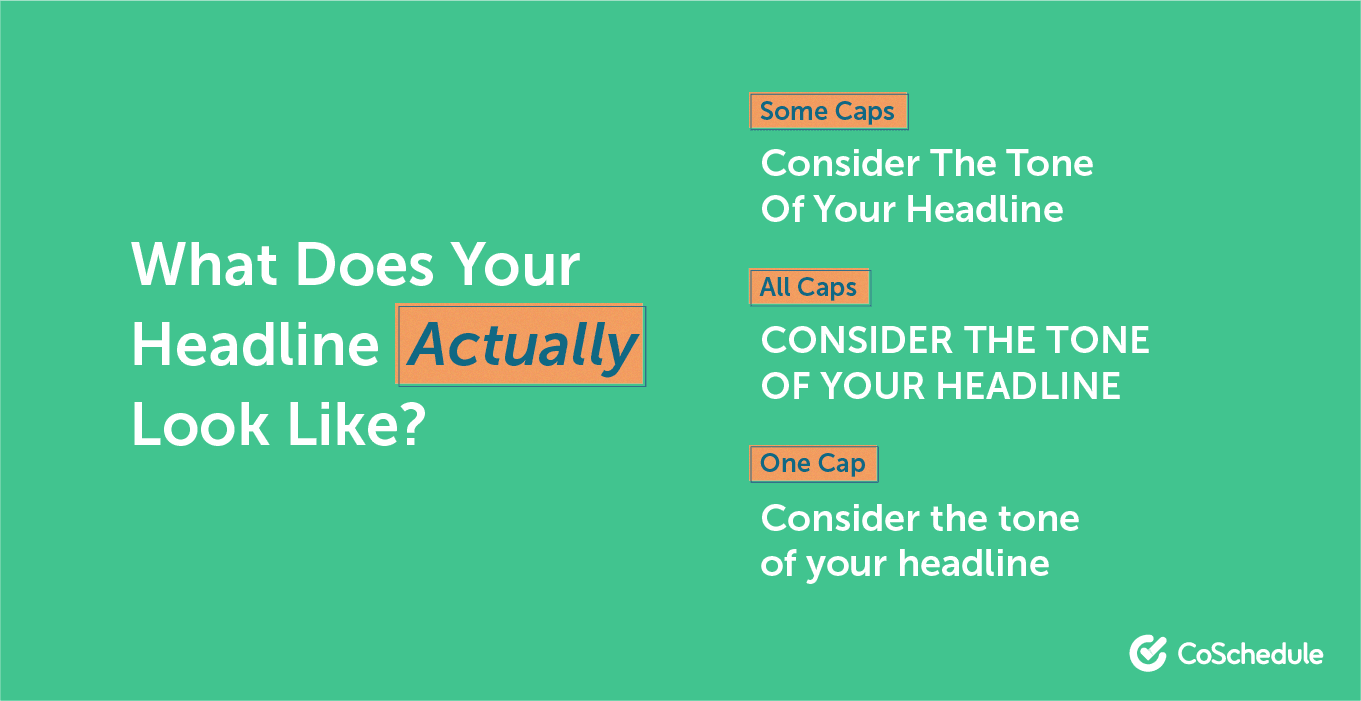
41. Choose a Strong Typeface
Choose a font that has a strong visual impact and a personality but also fits the body text. Here’s a list of the best Google fonts from Blog Charge to help you find the right font.
42. Size Your Headlines to Stand Out
Make your headline visibly larger than body text. Its size can make it really eye-catching, even when pushed to extreme.
According to a study by Smashing Magazine, most of the best blogs’ most popular headline sizes range from 20–36 pixels, or about 2.5 times larger than your body copy.
43. Use Color to Grab Attention
67% of people say black is the best choice to help them comprehend the content, but other tints can add some contrast and visual interest.
That study covered by Cutting Edge PR found 17% of people like bright colored headlines and another 52% say dark colored headlines make for good comprehension.
44. Align Your Headlines for the Biggest Impact
Centered headlines are most powerful, visually; left-centered are more conservative and formal. Avoid justifying headline type — it can lead to bad lettering.
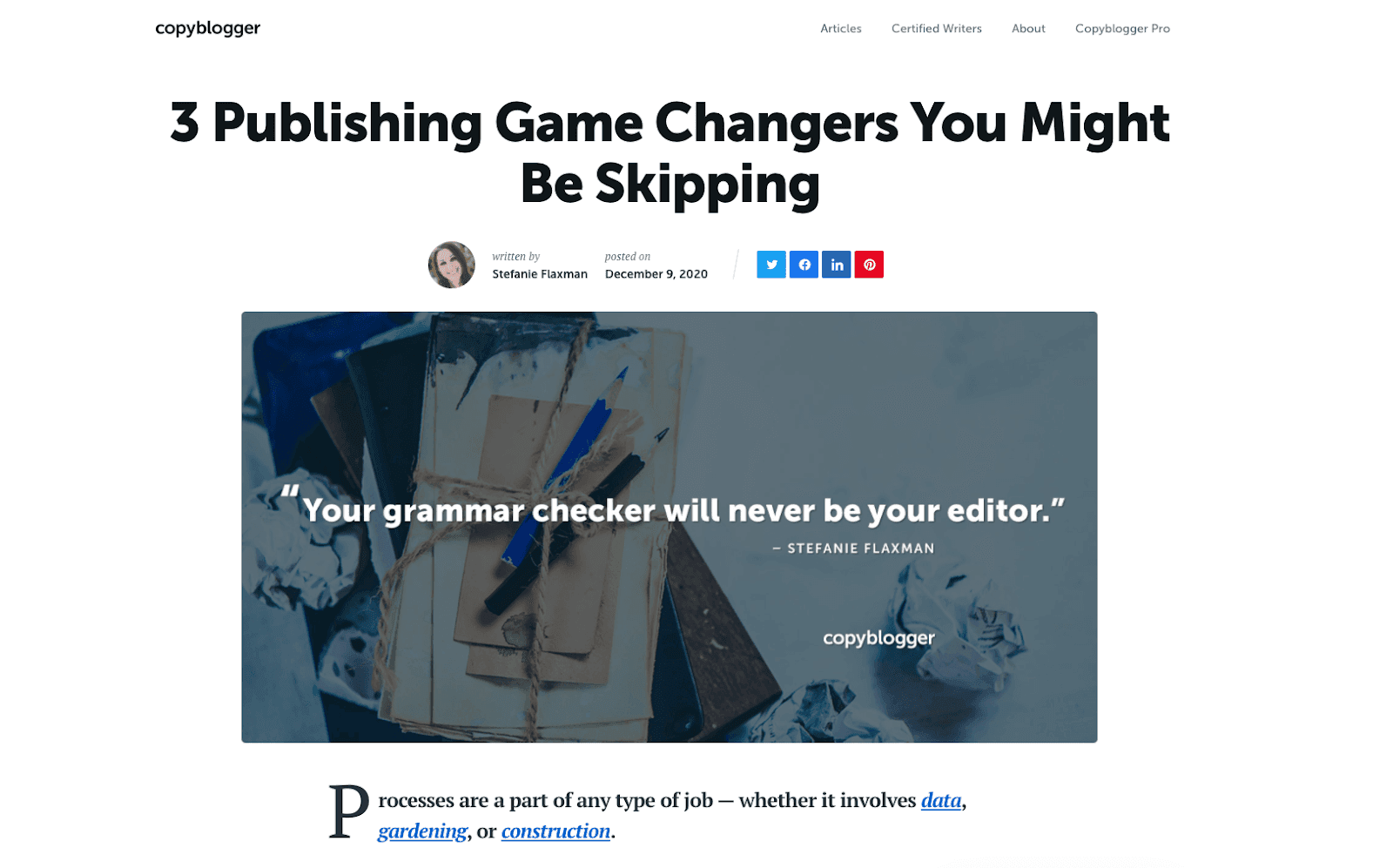
Source: CopyBlogger
45. Polish Your Headlines With Google
Your headlines deserve to be found. Here’s how to use Google to sharpen your headlines and ensure you optimize them for SEO.

46. Write for Search Engines to Help Your Readers Find Your Content
Search engines will best display headlines that are shorter than 70 characters, which is relevant if your title tag is the same as your headline.
Otherwise, you may need to shorten your headline to fit your title tag, so be sure to write headlines in a way that they’ll still make sense even if they need to be shortened a bit for search engines.
Title tags are the headers that appear when you look through a search engine, and it’s important that the entire title tag is visible to increase its chances of being clicked on — otherwise you’re asking your readers to blindly view your content.
Make sure your headline includes your target keyword as well.

47. Find Words Your Readers are Looking for With the Keyword Planner
Use Google Keyword Planner to understand the search terms your target audiences look for. Google’s official support documentation explains how to use it.
48. Try Using a Suggested Search Term in Your Headline
Just type the first words of your headline to see whether the auto-fill suggestions are similar to it. Ubersuggest is an easy, free tool that surfaces actual autocomplete data:

Recommended reading: 40 Effective YouTube Video Title Ideas To Boost Viewership
49. Look for Related Search Terms
This list appears at the bottom of your search page and shows you what terms are related to the one you typed. That feature helps people shake up their searches to find relevant and related information.

50. Use Google Trends
Google Trends will help you discover what the past and/or current topic interests are by whatever region of the world you would like to know about. Simply enter a search word or phrase, and “explore what the world is searching”.
Here is something information that pops up when you type in the search word “headlines”:
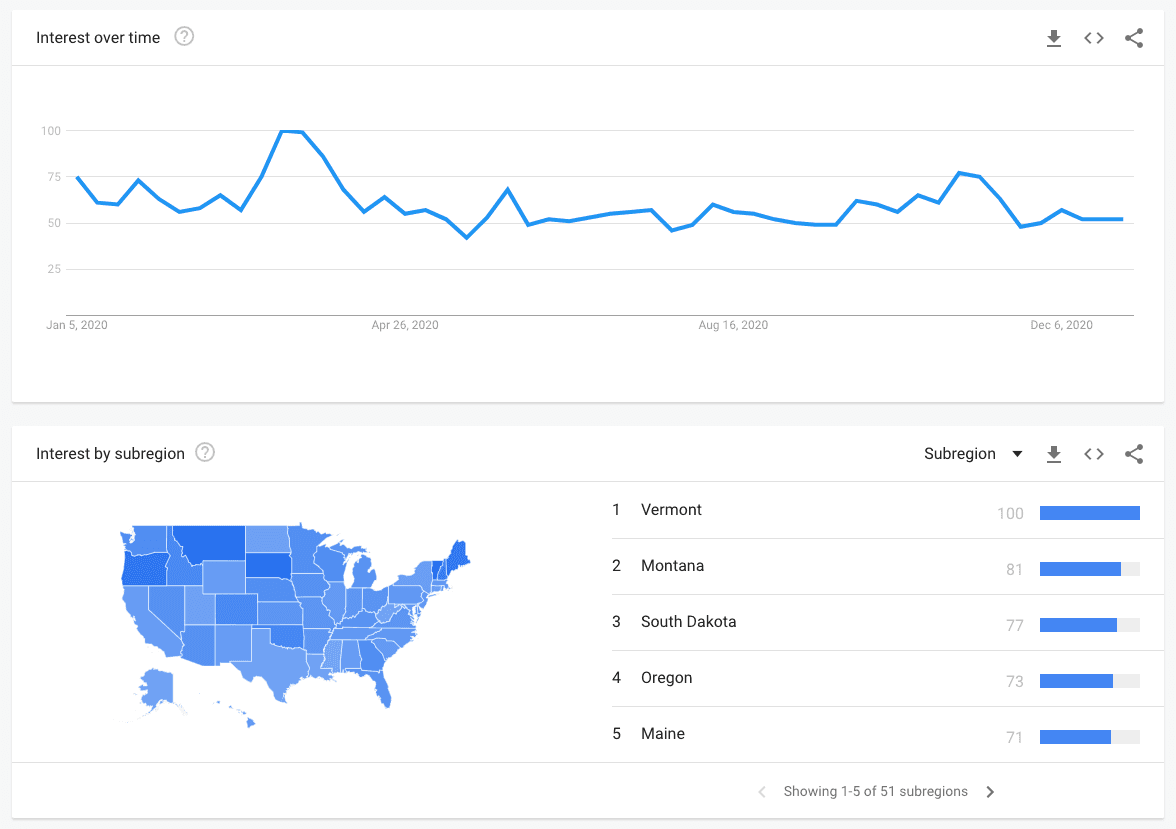
51. Keep Your Headlines Crisp and Clear
You don’t want to add any extra fluff to your headlines — get straight to the point and make sure that point is obvious. Headlines that briefly and specifically tell readers what they are going to get from your content are going to outperform all other headlines.
List posts get some of the most shares of any content type.
Read on to learn more about how to write your to-the-point headlines with clarity.
52. Use “You” to Address Your Readers
Address your reader as you. This simply grabs your readers’ attention and helps them relate the headline to their personal experience.
53. Promise a Solution to a Problem
Use that will, to, and so in your headlines. This kind of headline already promises a certain value to be taken from reading the content.
Think about how powerful these headlines sound:

54. Help Your Readers See a Better Future For Themselves
Think about this headline for a minute: “How To Do ___ That Will Help You ___”.
That headline — and others like it — clearly states the purpose of the content and boosts its accuracy in tackling one specific action or problem.
55. Keep It Simple
If you craft a headline that isn’t easily skimmable or it’s far too lengthy, your readers are bound to skip right over it. You only have a couple seconds to grab your reader’s attention before they continue glancing through their search results.
Headlines that are 55 characters long have been proven to be most effective in getting click-throughs.
56. Simple Doesn’t Have to Mean Generic
Generic headlines get buried and forgotten. If you wouldn’t read an article based on a headline you wrote, scrap it and write more until you score a winner.
Here’s an example of a generic headline:
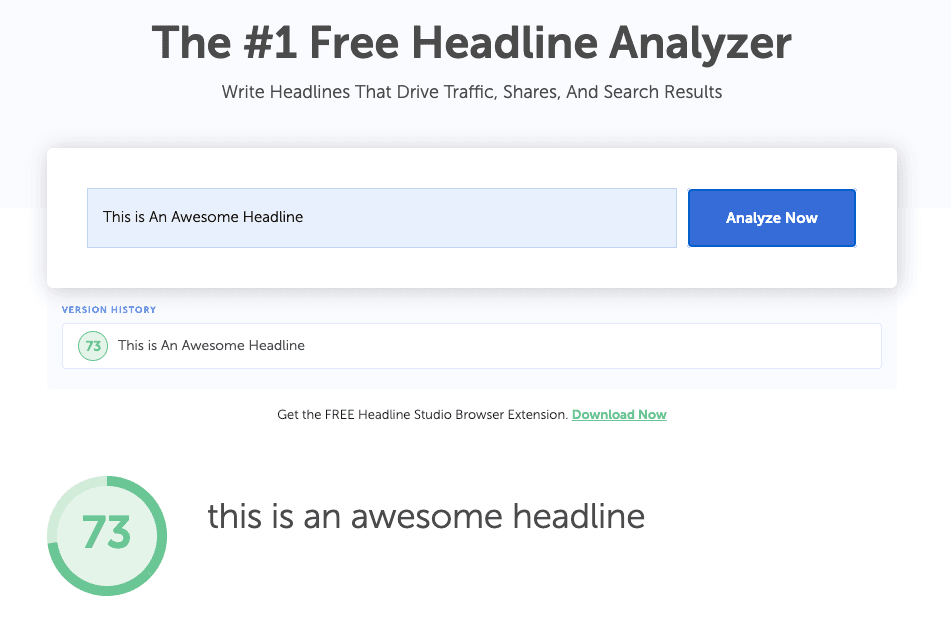
While this headline scores highly through CoSchedule’s Headline Analyzer Studio, there isn’t anything special or particular about its structure.
For even better headline results, try using a headline with a list or question format.
Pro Tip: The Headline Analyzer Studio will tell you when you write a generic headline.
57. Be Specific
Narrowly focus on the one topic your content is about. Consider the main point and benefit of your post, and get granular by telling your readers exactly what your content contains.
For example, “How To Write Headlines Better” is less specific than “30 Ways To Write More Emotional Headlines.”
58. Avoid Passive Voice
Use active instead of passive voice. Active is easier to understand when scanning for interesting headlines.
For example, turn a passive headline like “30 E-Books Written By Astronauts” headlines into “30 Astronauts Wrote 30 E-Books To Help You Become A Better Leader”.
59. Include Words that Reference Additional Content
If your blog post includes an infographic, guide, template, or other downloadable content, reference it in your headline. This gives readers added incentive to click, and provides more detail about the content your blog post includes.
Here’s a recent example on our own blog:The Best 2021 Social Media Content Calendar to Organize Every Post (Template).
60. Know Your Competition and Beat Them
If you’ve ever wondered how much content is created daily, here’s your answer: According to A Day in the Internet infographic by MBA Online, 2 million new blog posts, 294 billion emails, and 864,000 hours of videos are uploaded to the Internet every single day.
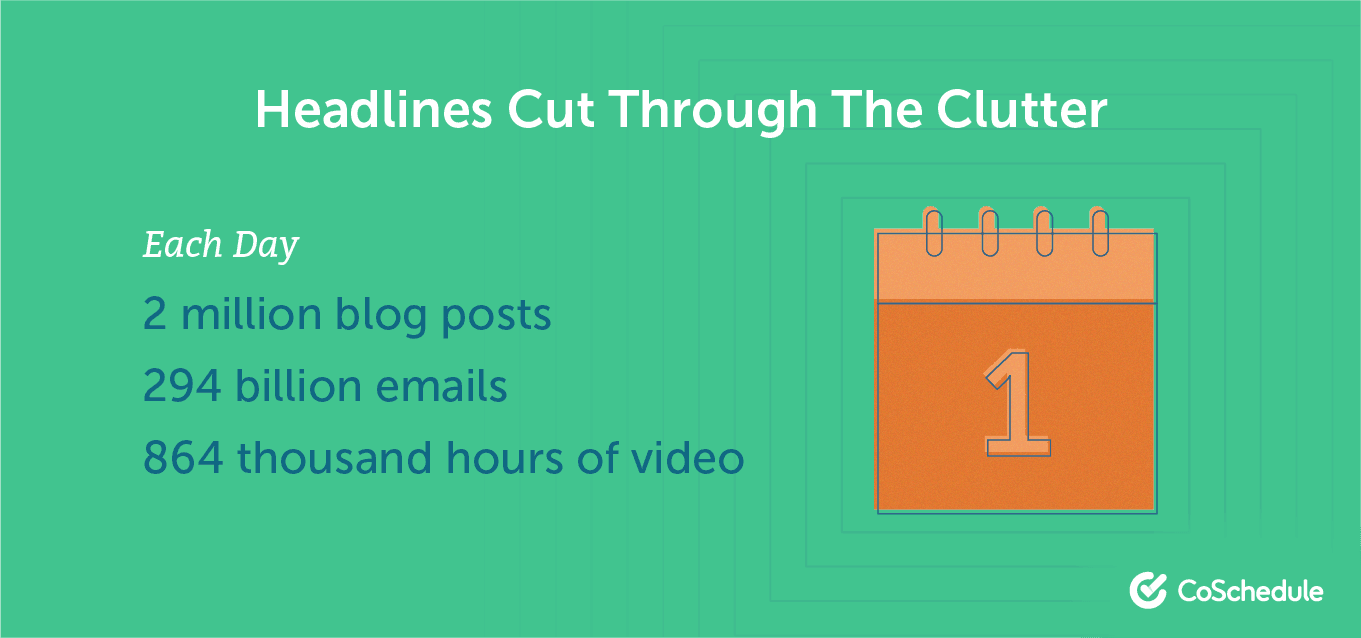
This means that you’re competing against lots of content. Being aware of such a degree of competition should only help you to work harder on your headlines and make them stand out from the crowd.
61. Differentiate Your Headlines From the Competition
Research what your competitors are doing. Identify the expressions, keywords, and phrases your competitors use in their content.
From there, you will understand how to make your headlines stand out.
For example, review your competition quickly for the 46 previous points (skim through their headlines with this information in mind), then brainstorm how to write headlines that will trump theirs.
62. Publish Headlines that Brand Your Content
Typically, when you’re publishing content, you’re trying to solve a problem or answer a question for your audience. The best way to promote your brand would be to inform your readers that your brand/product/service is the perfect solution to their problem.
An example of how to structure a headline like this could be “Why [BRAND] is the Best [PRODUCT/SERVICE CATEGORY]”. Then, make sure you clearly state those reasons throughout your content.
63. Try Headline Ideas You Haven’t Experimented With Before
Be creative! Don’t be afraid of testing new content on your audience. Even if your headline doesn’t bring a lot of traffic, you may get new ideas on what might.
64. Use Social Media for Simple A/B Testing
Twitter makes quick and easy A/B testing easy. Simply try writing two different headlines, and use them as tweets to promote your content.
Make sure each headline includes a different variable (for example, one could be negative, and the other positive). Then, see which performs best.
Over time, you’ll develop a clear picture of what clicks with your audience.
65. Contradict Common Wisdom
Is there a commonly accepted “truth” you want to challenge? Write a headline that clearly contradicts it.
Try something like, “Why {Insert Action} Doesn’t Actually Help {Insert Benefit}”. These types of headlines can generate a lot of attention (as long as you have data and evidence to support your counter-claim).
66. Repurpose, Repurpose, Repurpose
Great headlines deserve to be read. In fact, they deserve to be read more than once. These tips will teach you how to repurpose them for maximum mileage.
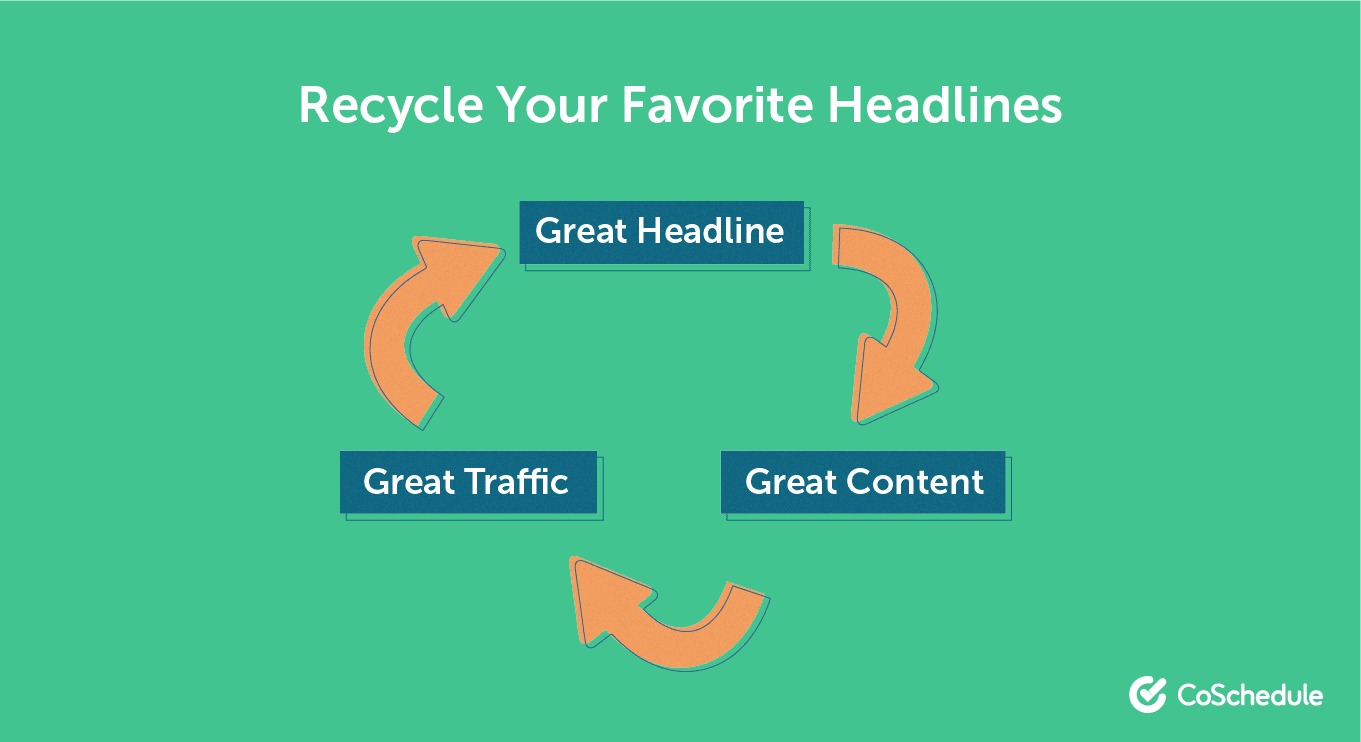
67. Recycle Your Old Ideas With New Headlines and Angles
Recycle your content. A great evergreen piece of content can be easily recycled under a different headline based on thorough research meant to broaden the gap between you and your competition.
68. Consider Every Platform Where Your Headline May Appear
It’s likely your content will be shared on social media. It’ll probably be in your email newsletter, too. Try to write headlines that can easily be adjusted for multiple formats (such as social media posts and email subject lines).
Recommended: Newspaper Headline Generator
69. Try Alternative Headlines for Social Media
What works well for a blog post might not work as well on social media. Consider writing alternative headlines to promote blog posts across various social channels.
This can also be an easy way to test different types of messaging to see what resonates most with your audience.
70. Condense Headlines for Email
Headlines that perform well in emails are usually around 50 characters long and feature the strongest words at their beginning. The Headline Analyzer Studio can help with this.
First, enter a headline. Then, scroll down to find the section pictured below:

71. Use Curiosity Gaps
Using curiosity gaps in your headlines is another easy way to pull in your readers because it encourages them to wonder. When you make your audience curious about something through your headline, they’ll be inclined to click on your content in order to soothe that curiosity.
Just make sure you’re avoiding creating clickbait in the process.
72. Use Power Words
Using one or two strong power words in your headline is a great way to connect with your audience. Incorporating words, like “boost”, “easy”, or “reward” are sure to entice your readers to click to find the easy or rewarding way to reach their goals.
73. Avoid Close-Ended Questions
You’re not going to want to ask an easily-answered question in your headline — otherwise, what’s the point of anyone clicking through to your content?
Make sure you’re asking questions that don’t have simple answers (i.e. “yes” or “no” questions), and then ensure you are actually answering those questions throughout your content. This tip goes hand in hand with using curiosity gaps in your headlines.
Go Forth and Write Better Headlines Now
The data from this post proves that headlines are crucial for getting your content read, increasing your social shares, and improving your brand.
Headlines are the first thing your readers will see, and it’s your job to convince them to click and read your content. Even if you only use one of the 55 tips from this post, you’ll be able to add a touch of uniqueness to every piece of content you publish.
Oh! And don’t forget to download our kit to help you write better headlines.
Note: This post has been updated from its original version. Kelly Smith, Garrett Moon, and Peyton Muldoon have contributed writing to this post. It was most recently updated on Feb. 17, 2021.
Recommended reading:
